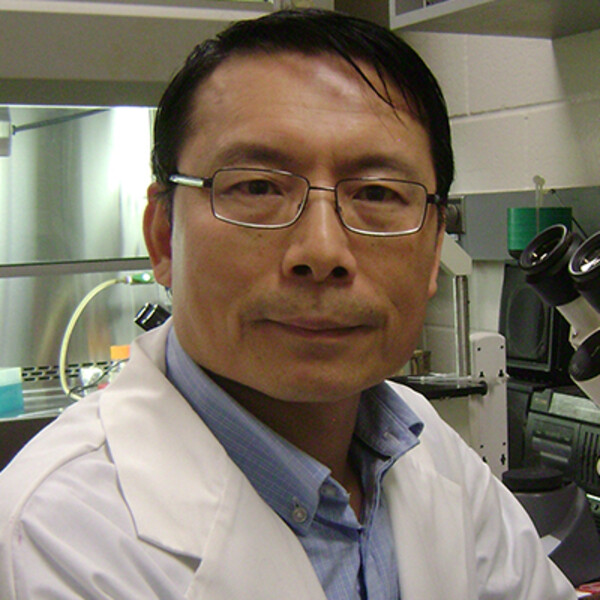Main Second Level Navigation
Burton Yang
BSc, MSc, PhD

Dr. Burton Yang received his Ph.D. degree from the University of Manitoba in 1992, followed by a postdoctoral training in Manitoba Institute of Cell Biology. He moved Harvard Medical School for a second postdoctoral training in 1993. Dr. Yang took a position as a scientist in Sunnybrook Health Sciences Centre and an assistant professor at the Department of Laboratory Medicine and Pathobiology, University of Toronto in 1995. He was promoted to associate professor in 2001 and professor in 2007.
Dr. Yang is currently a Career Investigator for Heart and Stroke Foundation of Ontario. Dr. Yang’s group has been working on the extracellular matrix, especially in the area of proteoglycan. Dr. Yang’s group undertakes the approaches of RNA interference including siRNAs and microRNAs to study the roles of matrix molecules in angiogenesis. Dr. Yang has developed a system to study the role of microRNA in tumor growth and angiogenesis in vitro and in vivo. Three approaches are taken to study miRNA function in transgenic mice expressing miR-17, versican 3’UTR, which can bind endogenous miRNAs and relieve mRNAs for translation, and anti-miR-378 construct.
Research Synopsis
Three approaches are taken to study miRNA function in transgenic mice expressing miR-17, versican 3’UTR, which can bind endogenous miRNAs and relieve mRNAs for translation, and anti-miR-378 construct.
Burton Yang’s lab has been taking three different approaches to study microRNA functions. In the first approach, they generated a transgenic mouse line expressing a microRNA precursor, miR-17. In the second approach, the group generated a transgenic mice expressing the 3’-untranslated region (UTR) of versican. The idea was that exogenous expressed 3’UTR will bind endogenous microRNAs and relieve mRNAs for translation. As a result, the protein levels are up-regulated. In the third approach, they developed a transgenic mouse line expressing the anti-sense construct of miR-378. The work has clinical application potentially.
Recent Publications
La Pierre et al. (2007) The ability of versican to simultaneously cause apoptotic resistance and sensitivity. Cancer Research. 67, 4742-4750.
Lee et al. (2007) MicroRNA mir-378 promotes cell survival, tumor growth, and angiogenesis by targeting Sufu and Fus-1 expression. Proc Natl Acad Sci USA, 104 (51), 20350-20355.
Shan et al. (2009) MicroRNA MiR-17 overexpression retards tissue growth and represses fibronectin expression. Nature Cell Biol. 11(8), 1031-1038
Fang et al. (2011) MiR-93 promotes tumor growth and angiogenesis by targeting integrin beta8. Oncogene 30(7): 806-21.
Jeyapalan et al. (2011) The CD44 3’-untranslated region inhibits breast cancer tumorigenesis, Nucleic Acids Research 39(8):3026-41.
Shatseva et al. (2011) MicroRNA miR-199a-3p regulates cell proliferative and survival by targeting Caveolin-2. J Cell Sci 124, 2826-36
Rutnam Z and Yang BB (2012) The non-coding 3’UTR of CD44 induces metastasis by regulating extracellular matrix functions, J Cell Sci 125, 2075-2085.
Siragam et al. (2012) MicroRNA miR-98 inhibits tumor angiogenesis by targeting activin type I receptors ALK4 of transforming growth factor-β superfamily, Oncotarget, 3(11):1370-85
Deng et al. (2013) The intermediate filament vimentin mediates microRNA miR-378 functionin cellular self-renewal by regulating the expression of the Sox2 transcription factor. J Biol Chem. 288(1):319-31
Du et al. (2013) MicroRNA miR-24 Enhances Tumor Invasion and Metastasis by Targeting PTPN9 and PTPRF to Promote EGF Signaling, J Cell Sci 126(6), 1440-53
Shan et al. (2013) Mature MiR-17-5p and passenger miR-17-3p induce hepatocellular carcinoma by targeting PTEN, GalNT7, and vimentin in different signal pathways. J Cell Sci 126(6), 1517-30.
Fang et al. (2013) Versican 3’-Untranslated Region (3’UTR) functions as a ceRNA in Inducing the Development of Hepatocellular Carcinoma by Regulating miRNA Activity. FASEB Journal. 27(3), 907-19.
Yang et al. (2013) Both mature miR-17-5p and passenger strand miR-17-3p target TIMP3 and induce prostate tumor growth and invasion. Nucleic Acids Research, 41(21):9688-704.
Rutnam et al. (2014) Pseudogene TUSC2P promotes TUSC2 function by binding multiple microRNAs. Nature Communications, 5:2914, 1-15
